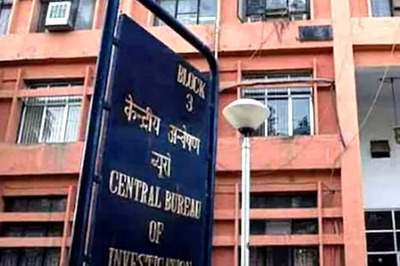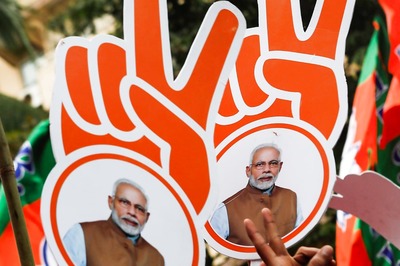
views
With over 15 cases of student suicides reported from Kota, the coaching hub in Rajasthan this year so far, the numbers have been consistent, except for the Covid pandemic, and last year when 28 such suicides, the highest in eight years, were reported from the city. The figure is still alarming and is despite the fact that the number of students enrolling in coaching institutes in the area is on a decline due to various factors, including online coaching and similar institutes coming up across cities, promising a bright future for young students preparing for competitive examinations for entry into top medical and engineering colleges.
The latest casualty was a 20-year-old medical aspirant, hailing from Uttar Pradesh’s Mirzapur, who was being treated for a neurological disorder. He had been living in a paying guest accommodation in the city for the past six months where he allegedly ended his life late on the night of October 16, making it the 15th suspected case of student suicide at the hub this year to date. Last month was no different, when a 21-year-old student, also preparing for the National Eligibility cum Entrance Test (NEET)-Undergraduate (UG), which is conducted for entry to medical colleges in India, also died of suicide.
It is only this year that the number of enrolments at the institutes in the city has reportedly gone low, which till this time of the year in 2023 was still packed with students. This year Kota saw around 30%-35% fewer enrolments than previous years. The NEET-UG result this year too seems to have had an impact with a larger number of top scorers emerging from Sikar than Kota. But whether it will have any impact on lowering the number of student suicides as well is still a wait-and-watch.
According to the state’s official data, 28 students ended their lives in Kota last year – the highest since 2015 (when the district administration started collecting data on student suicides). In 2022, 15 students died of suicide. No suicides were reported in 2021 and 2020, which were the Covid pandemic years when institutes were shut and mostly ran classes online. In 2019, 18 such deaths were reported, 20 in 2018, seven in 2017, 17 in 2016, and 18 in 2015.
Even though Kota may be losing the sheen of its coaching institutes, it’s the culture that is still deeply rooted and is going to stay until parents, as well as students, see a shift in their mindset, said psychologists, academicians, and counselling experts News18 spoke to on the grim situation.
Mimansa Singh Tanwar, clinical psychologist and head of Fortis School Mental Health Program, said that worldwide 75% of people facing suicidal thoughts don’t approach for help. For those taking the extreme step, for example, in the case of college students in highly competitive places like Kota, it’s like a “make or break situation” since they think that they don’t have a plan B. “When we look at suicides among college students, there are different kinds and levels of pressure they are enduring like family, financial, and peers. Often in such cases, even if there’s no active pressure as such, they are feeling it both externally and internally in their own minds since it’s so deeply embedded in the culture that they are seeing around them,” said Tanwar.
It is always a combination of two factors – immediate and long-term – she said. An immediate factor is the trigger, which could be a routine exam, in which a student has not performed well, but then the long-term factors like the ability to take stress, personality, a situation at home or financial pressure have been at play for some time and are responsible for bringing them to this verge of suicide.
“So, when we talk of prevention, the first step for institutions is to make awareness of handling pressure more periodic and consistent instead of it being a one-off thing. The second is to assess stress levels and build resilience, life skills and a longitudinal axis where a person’s life is not just about cracking an exam, but having several other plans in case one doesn’t work out. It’s also important how we talk about suicide in general since it also has a copycat aspect. If we keep talking about the methodology, that is what a student who might be contemplating it would just come to accept that this is what anyone facing similar stress is doing. We have to talk about the impact it left on their families and social peer groups to create a conversation countering the idea itself,” said Tanwar.
The highest number of students that land at Kota is those hailing from UP, Bihar, Madhya Pradesh (MP), Chhattisgarh, Jharkhand and Rajasthan itself, among others. Besides NEET, students at Kota come to prepare for the Joint Entrance Examination (JEE) – Mains and Advanced – which is conducted for entry to engineering colleges in the country.
NEET-UG and JEE are the country’s largest and toughest entrance exams conducted every year for students to get entry into premier engineering and medical institutes such as AIIMS, the IITs and NITs, among others.
Every year around 22 lakh students appear for NEET across the country, but there are only around 40,000 seats in government colleges. Most who come to Kota for NEET preparation are those who cannot afford private medical colleges. The competition is steep and those performing average just fall out of the circuit, as institutes are only scouting for star performers, who are then constituted in a different batch. The highest number of suicides has been reported among NEET aspirants, which has a much larger course content and relatively fewer seats, as compared to those in engineering colleges.
“The incidents are higher for NEET aspirants probably because they are much larger in numbers as compared to those preparing for JEE. Also, since the medical profession has been traditionally the most coveted with parents dreaming of their children becoming doctors, adding to the burden of expectations of scoring high since those getting a lesser rank do not have the possibility of getting into good government colleges. The point is that even if the numbers at Kota shrink, they may just expand somewhere else. Parents have to understand the child’s aptitude first before putting them in the rut, as they could be capable of doing many other things much better than struggling for years in coaching institutes,” said a physics teacher, who is also a counselling expert, teaching at an online platform.
According to Kamna Chhibber, clinical psychologist and head of the department of mental health and behavioural sciences at Fortis Healthcare, suicides are preventable, given that institutions have the training and sustained effort at it. “Often the case is that signs of distress go unnoticed. If we equip people in the surroundings, in this case, the institute, the mess or where students are staying, in identifying those showing such signs, listening to their conversations and linking them to the right kind of resources, suicide can be prevented. Look, listen, link – these are the three steps. Those surrounding the younger students can play a major role in identifying, tracing and supporting those showing signs of withdrawal. Counsellors can only provide crisis intervention. Those around, including teachers and parents, have to have a holistic view of life themselves to tell young people to look at life from a larger lens,” said Chhibber.




















Comments
0 comment